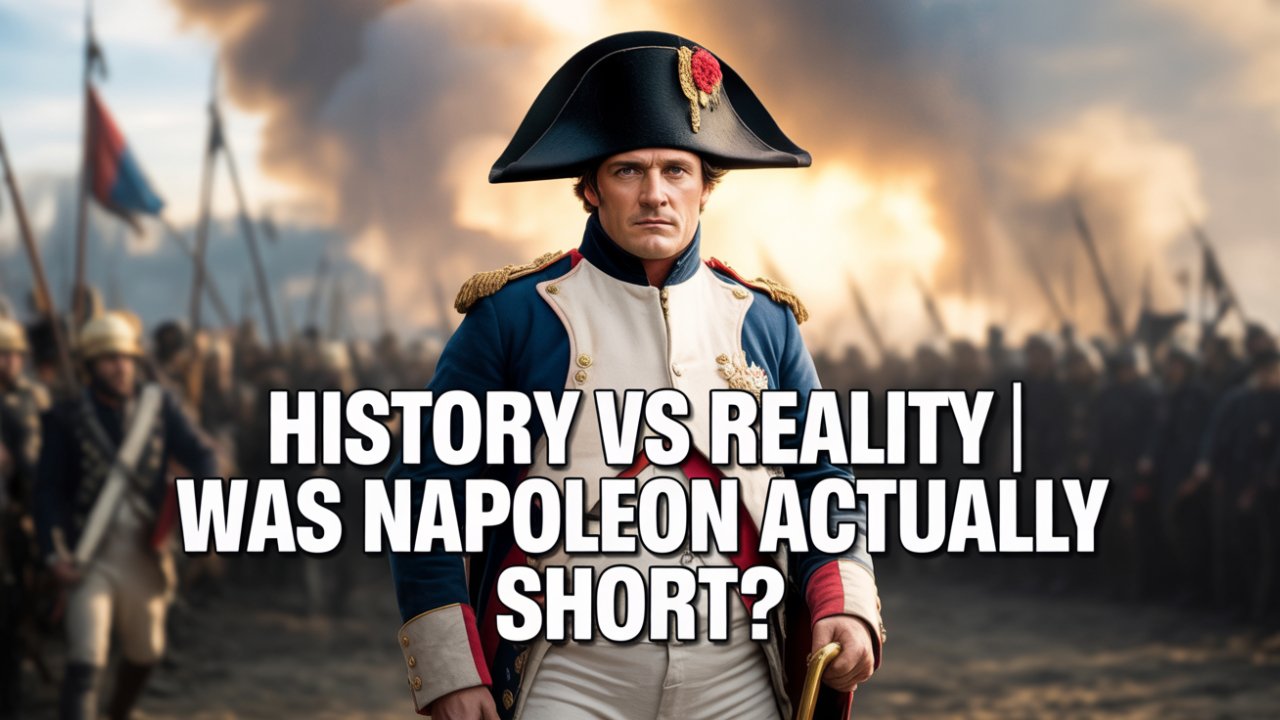Picture a smoke-filled battlefield, the air thick with gunpowder and the cries of men. And striding through the chaos is a single figure, hand tucked in his waistcoat, his ambition boundless. This is Napoleon Bonaparte, one of the most formidable figures in human history. A military genius who redrew the map of Europe. A political visionary whose legal code still shapes laws today. A name synonymous with power, conquest, and… well, being really, really short.
It’s an image burned into our minds. The tiny tyrant, the furious little general, a man whose colossal ambition was supposedly just compensating for his lack of height. This idea is so pervasive it even has its own psychological term: the “Napoleon Complex.” We see it in movies, we read it in books, we hear it in jokes. It’s the one thing everyone knows about Napoleon.
But what if I told you that this foundational “fact,” this image of a pint-sized dictator, is a complete fabrication? What if the story of Napoleon’s shortness is one of the most successful and enduring propaganda campaigns ever launched? It’s a lie, built on a simple measurement error, fueled by a rival nation’s fear, and cemented by two centuries of everyone just repeating it. Today, we’re not just correcting the record. We’re going to dismantle one of history’s greatest myths, piece by piece. So, how tall was Napoleon Bonaparte, really? The answer is not what you think.
Before we can expose the lie, we have to appreciate just how massive it is. The myth of the short Napoleon isn’t just a historical footnote; it’s a cultural institution. Think about it. How many times have you seen him portrayed on screen? From classic Hollywood epics to modern blockbusters, casting choices almost always lean towards shorter actors, or they use camera tricks to create the illusion of smallness. He’s a punchline in cartoons, a walking caricature in shows like Pinky and the Brain, where the world-conquering mouse gets mistaken for the Emperor himself, as onlookers whisper, “he really is tiny.”
And this image goes way beyond entertainment. It has wormed its way into our language and our very understanding of psychology. The term “Napoleon Complex” is casually thrown around to describe any shorter person with a confident or ambitious personality. It’s a shorthand that immediately paints a picture of someone overcompensating for a physical shortcoming. The great irony is that the man this “complex” is named for almost certainly didn’t have it, because he didn’t have the trait it’s based on. But the myth is so powerful that it has spawned its own field of pop psychology, influencing how we see leadership and ambition in relation to size.
And so the legend feeds itself. Someone hears Napoleon was short, so they repeat it. A filmmaker casts a short actor, which reinforces the image. A writer uses the “Napoleon Complex” as a character shortcut, cementing the idea in our culture. Every retelling, no matter how small, adds another layer to this great historical falsehood. It has become a piece of trivia so common, so accepted, that questioning it feels like questioning gravity. It’s a simple story that seems to explain a complex man: of course he tried to conquer the world, he was small. It’s neat, it’s tidy, and it’s satisfying.
But history is rarely neat and tidy. The truth about Napoleon’s height isn’t just about a few inches. It’s a story about how narratives are built, how enemies are demonized, and how easily a fiction, when repeated often enough, can overshadow reality. We’ve accepted this story for over two hundred years. We’ve let it define one of history’s most pivotal figures. But the story is wrong. And now, it’s time to set the record straight.
Alright, let’s cut right to the chase. The big reveal. Historical records, including his official autopsy report, state that Napoleon Bonaparte stood approximately 5 feet 6 and a half inches, or about 1.7 meters tall.
Now, in the 21st century, that might sound a little on the short side for a man, especially in the Western world. And that’s the first trap our modern minds fall into. We’re judging a man from the early 19th century by the standards of today, a time when nutrition and public health have dramatically increased average heights across the globe. To get the real picture, we have to go back to his time.
In the early 1800s, the average height for a man in France was roughly 5 feet 5 inches. Let that sink in for a moment. Napoleon, at around 5’7″, wasn’t just average. He was demonstrably taller than the average Frenchman of his era. He wasn’t looking up at his countrymen; many of them would have been looking up at him.
This single, verifiable fact shatters the entire myth. He wasn’t short. He wasn’t a “pipsqueak.” He wasn’t a “tiny tyrant.” He was a man of above-average height for his time and place. Even compared to the British, who were slightly taller than the French on average, he wouldn’t have been noticeably small.
To put it in today’s terms, it’s like calling a man who is six feet tall “short.” It makes no sense. So where did this colossal misunderstanding come from? If the data is so clear, how did the whole world get it so wrong?
The answer is a perfect storm of a few key factors: a confusing system of measurement that got lost in translation, a relentless propaganda war waged by his greatest enemy, and a few details about his daily life that were twisted to support the legend. This wasn’t an accident; it was constructed, brick by brick, with malicious intent. And the first brick was laid on a remote island in the South Atlantic, in the very room where Napoleon’s body lay.
The year is 1821. The place is the island of Saint Helena, where Napoleon has been exiled for six long years. On May 5th, the former Emperor dies. The next day, an autopsy is performed. In the room is his personal doctor, Francesco Antommarchi.
Dr. Antommarchi conducts the examination and, when it comes to height, he measures the body from head to heel and records the result: “5 pieds, 2 pouces.” Five feet, two inches.
This measurement, 5’2″, is the smoking gun. It’s where the myth begins. When this report made it back to England, the number was seized with glee. “Little Boney,” as British propagandists already called him, was now medically confirmed to be tiny. The English press ran with it, and the figure became fact.
But there’s a vital piece of information that was either deliberately ignored or conveniently lost in translation. Dr. Antommarchi was using the old French system of measurement, not the British Imperial system. And in that system, the units had the same names, but they were not the same size.
Before the metric system which Napoleon himself championed Europe was a mess of different measurement standards. The French foot was longer than the British foot. And more importantly, the French inch, or pouce, was about 2.7 centimeters, while the British inch was, and still is, about 2.54 centimeters.
This small difference adds up. Napoleon’s recorded height was 5 French feet and 2 French inches. A French foot had 12 pouces, so his height was 62 French inches. If we convert that to modern centimeters (62 x 2.7 cm), we get about 168.6 centimeters. Now, let’s convert that back to the British system. At 2.54 cm per inch, that comes out to over 66 inches, or 5 feet 6 inches. Some historians, using slightly different conversions, put him closer to 5’7″.
So there you have it. The autopsy that supposedly “proved” Napoleon was short actually proves the opposite. The 5’2″ figure was a simple mistranslation. It was like reporting a temperature of 20 degrees Celsius as “20 degrees” to an American, who would assume you meant Fahrenheit and think it was freezing, when it was actually a pleasant room temperature.
The British establishment, locked in a decades-long war with Napoleon, had no reason to clear this up. Why would they? The number “5 foot 2” was a gift. It was a simple, powerful tool of ridicule. The truth required a boring explanation of archaic measurement systems. The lie was punchy and much more effective. And so, the lie is what they chose to print. It was the first, and most critical, pillar of a myth that would stand for centuries. But it was far from the only one.
While the measurement mix-up gave the myth a scientific-sounding basis, its real engine was propaganda. To understand why, you have to grasp the sheer terror Napoleon inspired in his enemies, especially Great Britain. He wasn’t just another general; he was a revolutionary force, an unstoppable titan who brought the old monarchies of Europe to their knees. He was a direct threat to the British Empire.
When you’re faced with an enemy you can’t reliably beat on the battlefield, you have to fight him on other fronts. You have to attack his character, his legitimacy, his image. You have to cut him down to size literally. This is where the golden age of British caricature came in, and its most devastating weapon was an artist named James Gillray.
Gillray was a master of political satire, and he turned his viciously creative talents on Napoleon. Starting around 1803, he created the character that would define Napoleon for generations: “Little Boney.” Gillray’s great innovation was to shrink him, to make him a tiny, petulant child throwing a temper tantrum.
One of Gillray’s most famous cartoons is titled “Maniac ravings or Little Boney in a strong fit.” It shows a minuscule Napoleon in a rage, stomping and screaming over bad news from London. He looks pathetic, not frightening. Another iconic print, “The Plumb-pudding in danger,” shows the British Prime Minister calmly carving up the globe, while a tiny Napoleon can barely see over the table, struggling to hack off a piece of Europe for himself.
The psychological brilliance here is staggering. They didn’t just make fun of Napoleon; they reframed him. A powerful enemy is to be feared. A tiny, screaming man-child is to be mocked. Gillray and others produced hundreds of these images. They showed Napoleon struggling with an oversized sword or being held in the palm of the English king’s hand. This campaign sought to strip him of his mystique and demolish the aura of greatness he had so carefully cultivated.
The campaign was a massive success. People crowded around print shop windows to see the latest Gillray cartoon. The images were so powerful that Napoleon himself knew about them. He reportedly later admitted that the cartoonist James Gillray had done him more damage than a dozen generals. He was right. His armies were eventually defeated at Waterloo, but the image of “Little Boney,” the tiny tyrant, was a victory for British propaganda that has never been reversed. It became the accepted reality, a potent fiction that continues to this day.
With the myth’s main pillars the measurement error and propaganda in place, other “evidence” was twisted to fit the story. Two details are often cited as proof of Napoleon’s shortness, but they’ve been completely misunderstood.
The first is his famous nickname: “Le Petit Caporal,” or “The Little Corporal.” On the surface, that sounds like an open-and-shut case, right? His own men called him “little.” But the nickname had nothing to do with his physical height. It was a term of endearment and respect, earned in battle.
The name was given to him by his soldiers during his Italian Campaign around 1796. The story goes that at the Battle of Lodi, Napoleon, already a General-in-Chief, personally helped aim the cannons a dangerous job usually done by a corporal. His soldiers were amazed. Here was their general, sharing their risks. As a sign of affectionate camaraderie, they “promoted” him to corporal. The “petit” or “little” part was not a reference to his size but a term of fondness, like calling a leader “Chief.” It showed he was one of them. To twist this term of respect into a schoolyard taunt is to completely misunderstand the bond he had with his men.
The second piece of misleading evidence is his personal guard. Napoleon was often surrounded by the elite soldiers of his Imperial Guard. This was a handpicked unit of veterans who served as his bodyguards. To even be eligible, a soldier had to meet strict criteria, including a minimum height requirement. Grenadiers of the Guard, for instance, had to be exceptionally tall, often over six feet.
So, picture it: a man who is 5’7″, already taller than average, constantly surrounded by men who are all over six feet tall. Of course he’s going to look shorter by comparison! It’s an optical illusion. The imposing height of the Guard was meant to project an aura of elite power. But for a British cartoonist looking for an easy gag, the image was perfect. It reinforced the narrative they were already pushing: look at “Little Boney,” dwarfed by his own men. His most affectionate nickname and his most elite soldiers were both weaponized against him.
Perhaps the most incredible legacy of this two-hundred-year-old smear campaign isn’t historical, but psychological. The myth of the short Napoleon was so potent that it created a phantom condition that haunts us to this day: the Napoleon Complex.
The term was popularized in the early 20th century by the psychotherapist Alfred Adler. Adler had a theory of the “inferiority complex,” suggesting that people who feel inferior in one area will overcompensate in others. He used Napoleon as a prime example: a man believed to be physically small who compensated by seeking immense power and conquest. And so, the “Napoleon Complex” or “Short Man Syndrome” was born.
The idea took root in pop culture and has been there ever since. It’s a simple concept that seems to explain a certain type of behavior. We see a shorter man who is assertive and we nod knowingly a classic Napoleon Complex. It’s a cultural stereotype that many believe is a real, recognized condition.
But here’s the final, crushing irony: The Napoleon Complex, as a clinical diagnosis, does not exist. It’s not listed in the Diagnostic and Statistical Manual of Mental Disorders (DSM), the official guide for psychiatric conditions. It’s a pop-psychology label, not a scientific reality. Moreover, modern studies have overwhelmingly found the stereotype to be a myth. For example, a 2007 study concluded that shorter men were actually less likely to lose their tempers than men of average height. The stereotype persists because of confirmation bias. When we see a tall person acting aggressively, we just see an aggressive person. When we see a short person doing it, our culture has trained us to blame their height.
So, the ultimate legacy of the lie about Napoleon’s height is a fake psychological condition named after him, based on a physical trait he never had, to describe a behavior that is not statistically supported. It’s an echo of James Gillray’s cartoons still reverberating in the 21st century, and a powerful reminder of how a historical lie can create real-world stereotypes that affect real people.
So, let’s return to that figure on the battlefield, Napoleon Bonaparte. We now know the truth. He wasn’t a tiny man. He stood at a respectable 5’7″, taller than the average man of his time. The story of his smallness is a fiction, a ghost story told by his enemies.
We’ve seen how this ghost was born from a simple mistranslation of an old French measurement. We’ve seen how it was given its power by a relentless British propaganda machine that saw ridicule as its sharpest weapon. And we’ve seen how it was kept alive by twisting the truth, turning a nickname of endearment and the elite stature of his guard into false evidence against him.
The story of Napoleon’s height is more than just trivia. It’s a powerful case study in how myths are made. It shows how easily a lie can become history, especially when that lie is simpler and serves powerful interests. It shows how a narrative, repeated for centuries, can embed itself so deeply in our culture that it creates its own psychological baggage.
It’s a stark reminder that history is not just a collection of facts, but a story that is told. And who tells that story matters. For two hundred years, the story of Napoleon’s height was told by his enemies. But the historical record, the actual evidence, tells a different, and much taller, tale.
What other historical “facts” do you think might be a lie? Are there other myths that you’ve always wondered about? Let me know in the comments below. I read every single one. And if you want to see more history that debunks the myths you thought you knew, make sure to subscribe and hit that notification bell, so you don’t miss our next investigation into history versus reality.





